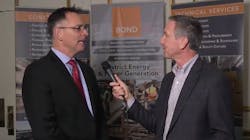In this video interview from Microgrid 2017 in Boston, Tim Peer, vice president, district energy, at BOND Brothers, explains to Kevin Normandeau, Microgrid Knowledge publisher, how microgrids, distributed energy and combined heat and power (CHP) can lead to lower operating costs and increased resiliency.
BOND Brothers, a northeast-based construction manager and general contracting company, serves institutional clients, including colleges and universities, utility companies and healthcare.
Peer specifically focuses on district energy, which includes district heating, district cooling and microgrids — as well as an integrated approach to all three.
[clickToTweet tweet=”Tim Peer – I see an increased value in distributed energy resources, especially around CHP. #microgrids” quote=”Tim Peer – I see an increased value in distributed energy resources, especially around CHP. #microgrids”]
During Peer’s presentation at Microgrid 2017, he described why interest is growing in distributed energy and CHP.
“I see an increased value in distributed energy resources especially around CHP, coupled with a low-grade BTU thermal distribution system,” Peer said. “That allows for maximum efficiency of the assets…with the CHP component, you can build in the resiliency that’s really valued here in the Northeast.”
Microgrid 2017 was sold out! Register now for Microgrid 2018 in Chicago.
Peer explained that BOND Brothers, as well as the industry as a whole, is continuing to explore how to extract additional value from these high efficiency systems.
Sometimes the financial hurdles to CHP can be a bit high. But that changes “when you build in the valuation around the resiliency benefit,” he said.
In fact, just a week before Microgrid 2017, Massachusetts experienced a damaging storm with high winds that left more than 1.5 million without power.
Peer pointed out that the companies and institutions that had on-site generation were able to “ride through” the weather event with no outages.
“And that’s an additional benefit that people are beginning to value more these days,” Peer concluded.
Tim Peer is vice president of district energy at BOND Brothers.
Read more about the benefits of CHP and microgrids. Subscribe to the free Microgrid Knowledge newsletter.







